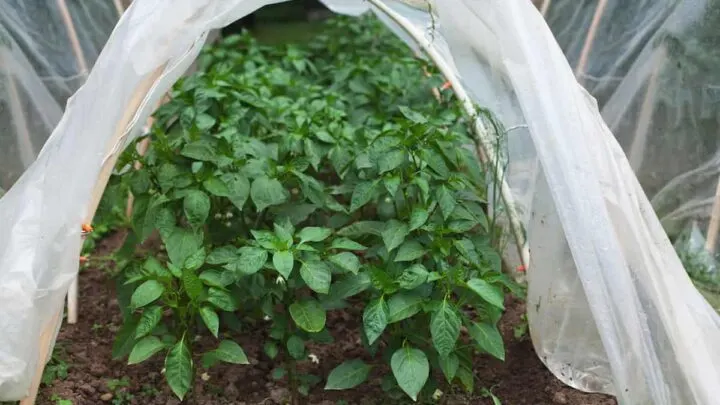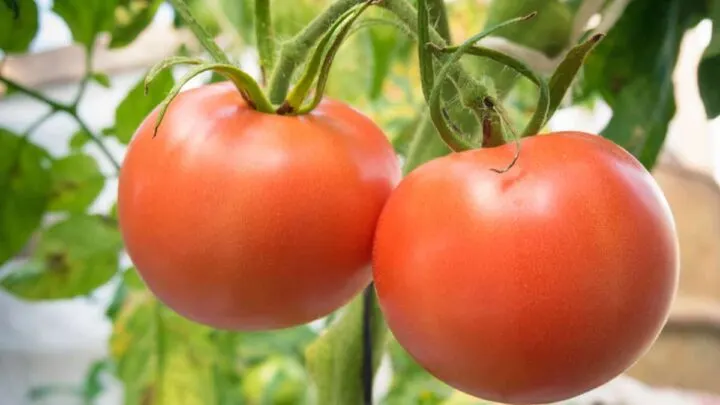Tomatoes and bell peppers might taste wonderful in a salad, but you wouldn’t mistake these two vegetables for one another, would you?
If you were looking at them in a garden, you might.
There are some key differences between tomato plants and bell pepper plants (really all peppers, but we’re going to focus on bell peppers). Still, gardening novices and gardeners new to these crops might be unable to spot the differences immediately.
You need to know to tell these two important garden crops apart.

How Do You Tell Tomato Plants From Pepper Plants
Tomato and bell pepper plants look remarkably similar in the seedling phase and stay similar until tomato plants start to outgrow bell peppers.
That can make it difficult for gardeners, especially gardeners new to these crops, to tell the difference between the plants.
Unfortunately, tomatoes and bell peppers need slightly different care during growth, so getting them confused can significantly reduce the size of your harvest.
The good news is that there are some differences between the two plants, despite their similarities.
Here’s a basic table showing some of the similarities and differences between tomatoes and bell peppers:
Differences In Plant Growth And Lifestages
| Tomato Plants | Bell Pepper Plants | |
| Adult Height | 2-6ft | 3-3.5ft |
| Color | Bright Green | Dark Green |
| Leaf Type | Alternate Lobed and Toothed | Alternating Smooth Edged |
| Growing Season Requirements | 50-90 Days | 60-90 Days |
| Water Requirements | 1-3in per week | 1-2in per week |
| Sun Requirements | Full direct sunlight – 8hrs | Full direct sunlight – 6hrs |
| Fruiting Season | Usually between July-Sept | June-July and Sept-Nov (warm climates) |
As you can see, there’s a fair amount of similarity between these two plants, but there are a few ways you can tell them apart, like the color of the plant and the shape of the leaves.
These differences will start in both plants when they’ve developed about four leaves, but they may look almost identical until that point.
So, if you have unidentifiable seedlings, don’t worry. Give them another week or so, and you should be able to tell these vegetables apart.

How Do You Identify Tomato Plants From The Leaves?
Identifying tomato leaves is one of the easiest ways to tell these two plants apart. It can also make identifying the differences between tomatoes and other vegetables easier.
The first thing to know is that tomato leaves are lobed, which means that a normal fully-developed leaf has multiple sections and points.
They’re also mildly toothed, meaning each section of a leaf may have more than one point along the edges.
Tomato leaves are usually bright green, not dark green, and they may feel and appear slightly fuzzy depending on the variety you’re working with.
How Do You Identify Pepper Plants From The Leaves?
Pepper plants are also usually identified using their leaves since they have very distinct leaves.
Unlike tomatoes, pepper leaves aren’t lobed or toothed. Each long, almost diamond-shaped leaf comes to a single point at the end unless it’s been damaged.
The leaves are also smooth, with a waxy shine that’s very different from the slight fuzziness on tomato leaves.
When identifying pepper leaves, you should also look for the color. Almost all varieties of pepper, from sweet bell peppers to spicy hot peppers like jalapenos or habaneros, have dark green leaves several shades darker than other vegetables like tomatoes, squash, or beans.

How To Tell Tomatoes and Bell Peppers Apart From Their Stems
If you aren’t already certain what kind of plant you’re dealing with after looking at the leaves, you can also tell tomatoes and bell peppers apart by looking at the plant’s stem.
Tomato stems are usually very distinct. They’re covered in small hair-like structures, which give the tomato stem a fuzzy look and rough texture in your hand.
Your skin is also relatively likely to get irritated touching tomato plant stems directly since those hairs are designed to be a defense mechanism for the plant.
Bell peppers, on the other hand, are smooth and can look like they’re covered in a thin layer of shiny wax.
When you look at the two plants side by side, you’ll also notice that the stem of bell pepper plants is significantly darker colored than tomato plants. They’re both green, but tomatoes have lighter green stems and leaves that are a little darker. Bell pepper plants are uniformly dark emerald green.
Do Tomato Plants Grow Faster Than Pepper Plants?
Yes and no. One of the ways many gardeners recommend telling young tomato and pepper plants apart is to see which seedlings grow faster, but that isn’t as surefire a technique as you might think.
While some tomato plants get much bigger than pepper plants, not all of them and early growth is remarkably similar.
Early harvest tomato plants might begin to outpace pepper plant growth at about the 6-in mark, while other tomatoes won’t start growing faster until they’re almost a foot tall or taller.
So, using this technique if you need to, leaf and stem identification is usually much more reliable and can be done sooner than comparing growth rates.

How Are Tomatoes And Bell Peppers Used?
If you’re new to growing these vegetables for yourself, it’s possible that you don’t know that much about how to use them either.
While we can’t be exhaustive (every gardener has their favorite recipes), having an idea of how the vegetable taste and how they can be used and preserved will help you find ways to use your first and future harvests!
| Tomatoes | Bell Peppers | |
| How Long They Stay Fresh | 3 days – 1 week | 1-2 weeks on average |
| Do They Can Well? | Yes | Pickled peppers can better – Otherwise use a pressure canner. |
| Do They Freeze Well | When sliced fresh and frozen yes – otherwise no. | Yes, freeze whole, sliced, or cooked. |
| Signature Taste | Mild, tangy, mildly sweet, versatile flavor. | Green – Slightly bitter vegetable flavor. Red, yellow, or orange – Sweet and slightly citrusy |
| Common Uses | Salads, pasta sauces, soups and stews, casseroles, curries, and condiments. | Salads, pizza topping, bread topping, pasta vegetable, soup and stew vegetable, stuffed and baked. |
These vegetables are highly versatile and can be used in almost any kind of food and served either cooked or fresh.
Bell peppers may be slightly more versatile, but tomatoes are used as a starting point for a wide variety of sauce-based foods, as well as a wide variety of condiments.
As a note, gardeners with a nightshade sensitivity may not want to grow tomatoes because tomatoes are a nightshade and a common cause of nightshade sensitivity reactions.
The primary flavor of tomatoes is usually slightly acidic, though some varieties are sweeter. Heirlooms are usually more flavorful than modern varieties but also harder to cultivate and store.
The primary flavor of bell peppers is usually sweet, becoming more savory when cooked. Roasted peppers develop both sweet and savory flavors. Bell peppers of all varieties are easy to store but may not always can well if you want to preserve them.

Hi there, my name is Allie and welcome to my blog; GareningWithAllie!
Much of what you see written here is just our personal experiences with gardening. Along with the content I write here, there is also a unique collection of gardening topics covered by some of our close friends. I hope you find everything you read here to be helpful, informative, and something that can make your gardening journey the most lovely experience ever! With that said, Happy Gardening!
